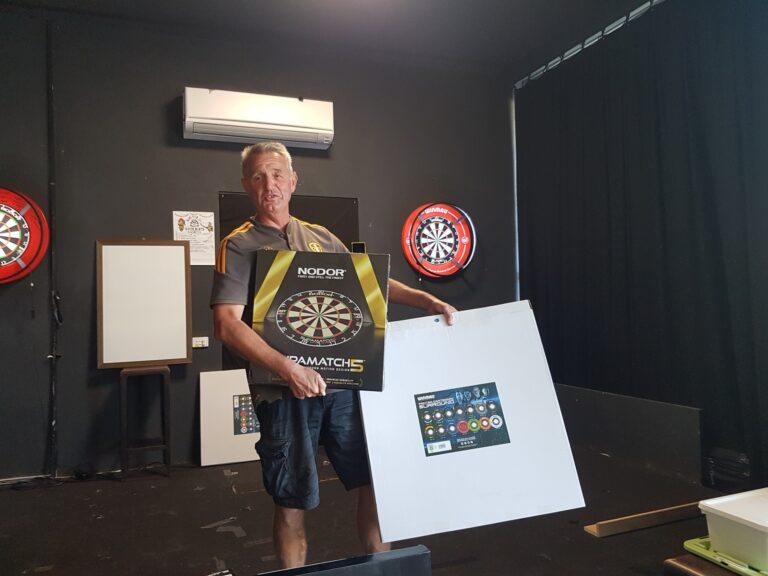Enhancing Your Dart Grip: Precision Vs Comfort
When you’re aiming to enhance your dart grip, the challenge lies in striking the right balance between precision and comfort. You might wonder whether focusing on finger placement or adjusting grip pressure can help you achieve better stability and control. Is it more important to have a grip that guarantees accurate throws, or should you prioritise comfort to avoid fatigue during long games? Exploring different grip styles and personalising your approach based on hand size and playing style can greatly impact your performance. So, how do you find that perfect blend to elevate your game?
Key Takeaways
- Experiment with finger placement for a personalised balance between precision and comfort.
- Adjust the grip pressure to enhance control without causing tension or discomfort.
- Utilise pencil or claw grip styles to find the most stable and accurate hold.
- Tailor your grip to match hand size and strength for optimal performance.
- Practice with grip training tools to improve consistency and stability in your throw.
Understanding Dart Grip Basics
Mastering the basics of dart grip is essential for achieving both precision and comfort in your throws. A well-balanced grip provides the stability needed to control the dart’s flight while ensuring that your hand feels relaxed. It’s a delicate balance that requires some experimentation to perfect.
Your grip pressure has a great impact on the trajectory and accuracy of your throws. Holding the dart too tightly can cause tension in your hand and wrist, leading to erratic throws. On the other hand, a grip that’s too loose may result in a lack of control. Aim for a grip that’s firm yet relaxed, allowing you to guide the dart smoothly.
To find this balance, start by experimenting with how tightly you hold the dart. Gradually adjust your grip pressure until you find a level that feels natural and allows for consistent throws. Remember, the goal is to maintain a stable yet comfortable hold.
Consistent practice is key in developing muscle memory for a reliable grip. The more you practice, the more your muscles will remember the best pressure and positioning, making your grip second nature. This foundation will set you up for success in refining your dart-throwing technique.
Finger Placement Techniques
Once you’ve established a comfortable grip pressure, the next step is to focus on finger placement techniques to further refine your dart control. Start by experimenting with placing the dart mainly between your thumb and index finger. This method often provides a good balance of control and stability.
Don’t hesitate to involve your middle finger in the grip. Adding this finger can give you extra support and enhance your overall grip technique. You might find that positioning the dart closer to the tips of your fingers helps increase your accuracy and precision. It’s all about finding what works best for you.
Adjust the placement of your ring and little fingers to see how it affects the feel and release of the dart. Sometimes, these minor adjustments can make a significant difference in how smoothly the dart leaves your hand. Your ultimate goal should be finding a finger placement that allows for a clean and consistent release.
Balancing Grip Pressure
Finding the right grip pressure is crucial for maintaining control and accuracy in your dart throws. When you balance grip pressure correctly, you enhance your throwing consistency. It’s all about finding the sweet spot between firmness and flexibility.
Too much pressure can cause tension, disrupting your release. On the other hand, too little pressure can make you lose control over the dart. You need to aim for consistent grip pressure to guarantee a smooth and fluid release.
This consistency directly impacts your overall performance, helping you hit your targets more reliably. It’s not just about holding the dart; it’s about how you hold it every single time. To determine the ideal grip pressure, practice and experimentation are key.
Spend time throwing darts with varying levels of pressure. Notice how different pressures affect your throws. You’ll find that a balanced grip gives you better control and accuracy.
Exploring Grip Styles
When exploring grip styles, you’ll find techniques like the pencil grip and claw grip that each offer distinct advantages.
Pay attention to finger placement, as it plays an important role in stability and control.
Understanding these variations can greatly impact your throwing accuracy and comfort.
Pencil Grip Technique
The pencil grip technique, used by dart legends like Phil Taylor, offers you unmatched control and accuracy in your throw. This method involves holding the dart similarly to a pencil, which gives you a precise and stable grip. By positioning the dart between your thumb and forefinger, you achieve a focused point of release that enhances your throwing consistency.
When you use the pencil grip, you benefit from:
- Stability: The grip minimises unnecessary movements, ensuring a steady throw.
- Control: Holding the dart like a pencil enables you to fine-tune your aim.
- Consistency: A clean and controlled release is essential for hitting your targets regularly.
Players who prioritise precision often choose the pencil grip technique. It’s designed to help you maintain a steady hand and deliver accurate throws. This grip style is particularly useful if you’re looking to improve your game’s consistency and avoid common pitfalls like wobbling or wayward throws.
Adopting the pencil grip might require some practice, but the payoff in terms of control and accuracy is well worth the effort. Whether you’re a seasoned player or just starting, this technique can greatly enhance your dart-throwing skills.
Claw Grip Variations
While the pencil grip emphasises precision, the claw grip offers a unique blend of control and stability for your dart throws. Holding the dart mainly with your thumb and middle finger, this grip resembles a claw-like position, ensuring a more consistent release. The claw grip style can be particularly advantageous for players seeking enhanced control and a secure hold on the dart.
Experimenting with variations of the claw grip is key to finding what works best for you. You can adjust the angle of the dart in your hand or modify the pressure applied by your fingers. These small tweaks can have a significant impact on your comfort and accuracy. Players often find that the claw grip provides a comfortable and secure hold, contributing to more accurate throws.
To help you visualise these variations, consider the following table:
| Variation | Description |
|---|---|
| Angle Adjustment | Changing the dart’s angle in your hand |
| Finger Pressure | Varying the pressure applied by your fingers |
| Grip Tightness | Modifying how tightly you hold the dart |
Finger Placement Importance
Proper finger placement plays a crucial role in stabilising, guiding, and propelling your dart towards the target. Your thumb and forefinger are the main holders, providing the primary control needed during the throw.
Experimenting with the positions of your middle, ring, and little fingers can greatly impact the dart’s balance and trajectory. Finding the right balance between control and comfort in finger placement is essential for a consistent and accurate throw.
To achieve an effective grip, keep in mind the following:
- Thumb and Forefinger: These should hold the dart firmly but not too tight, ensuring control without tension.
- Middle Finger: Experiment with positioning it along the barrel or just behind it for added stability.
- Ring and Little Fingers: These can offer additional support and balance but should remain relaxed to avoid tension.
Each finger’s contribution to the grip should aim for a fluid and consistent throwing motion. This enhances overall accuracy and helps maintain a seamless release.
Don’t forget, comfort is just as important as precision. Adjust your fingers until you find a grip that feels both secure and natural. Practicing regularly with this in mind will lead to an improved and more reliable throw.
Personalising Your Dart Grip
Personalising your dart grip starts with discovering your style by experimenting with different finger positions and grip pressures.
Try adjusting your grip for better control and see how slight changes can improve your accuracy.
It’s all about finding what feels natural and allows for a smooth, consistent throw.
Discover Your Style
Have you ever wondered how small adjustments in your dart grip could dramatically improve your game? Personalising your dart grip is crucial to finding a balance between precision and comfort. By experimenting with different finger placements and pressures, you can discover a grip style that feels natural and suits your unique preferences.
Tailoring your grip involves focusing on:
- Hand size: Adjust your grip to fit your hand size, making sure it feels neither too tight nor too loose.
- Strength: Modify the pressure you apply on the dart to match your hand strength, preventing fatigue and improving control.
- Comfort level: Ensure your grip is comfortable, allowing you to maintain consistency and control over the dart’s trajectory.
Achieving a comfortable grip that also offers precision can enhance your throwing accuracy. It’s about making small adjustments based on what feels right to you.
For instance, you might find that a slight shift in finger placement or a minor change in pressure makes a significant difference in your performance.
Experiment With Positions
Now that you’ve identified your style, it’s time to experiment with different finger positions to further personalise your dart grip. Try shifting your grip to the front, middle, or rear of the dart to see which position feels most comfortable and effective for you. Each position offers a unique balance between precision and comfort, so adjust slightly to find your sweet spot.
Ensure your grip allows for a clean and consistent release. Consistency is key, regardless of where your fingers are placed. Think about your hand size, strength, and natural tendencies. These factors will influence what grip works best for you. A grip that suits your unique playing style can greatly enhance your performance.
Adjust for Control
To enhance your dart control, experiment with finger placements and pressure to discover the ideal balance between precision and comfort. Adjusting your grip is essential for achieving better accuracy and consistency in your throws.
Start by holding your dart and making small changes to how your fingers are positioned and the amount of pressure you apply.
Personalising your dart grip involves these key adjustments:
- Finger positions: Try altering the placement of your thumb, index, and middle fingers. Experiment with different angles and distances to find what feels most stable.
- Grip pressure: Vary the intensity of your grip. Some players find a lighter touch offers better precision, while others prefer a firmer hold for control.
- Release technique: Practice different release points and methods. A smooth, consistent release can greatly enhance your accuracy.
Focus on finding a grip that feels natural yet offers the control you need. It’s a process of trial and error, but the right grip can significantly improve your performance.
Training for Grip Enhancement
Enhancing your dart grip requires a dedicated regimen of specific exercises designed to improve both strength and coordination. Start with regular grip strength exercises to build stability and control. Simple tools like stress balls or grip trainers are excellent for this purpose.
Next, practice grip-release drills to boost finger coordination and consistency. For instance, try releasing the dart slowly and smoothly, focusing on your finger movements. This helps in developing muscle memory, which is critical for executing a consistent throw.
Experiment with slight adjustments in grip pressure. Sometimes a minor tweak can make a significant difference in your dart control. Aim for a balance where your grip is firm but not overly tight.
Incorporate grip endurance exercises, especially if you plan on long practice sessions. Squeeze a stress ball for extended periods or use a hand gripper to build endurance.
Here’s a breakdown of the exercises:
| Exercise Type | Purpose | Tools Needed |
|---|---|---|
| Grip Strength | Enhance stability and control | Stress balls, grip trainers |
| Grip Release Drills | Improve coordination and consistency | Darts |
| Grip Pressure Adjustments | best dart control | None |
| Grip Endurance | Build strength for long sessions | Stress balls, hand grippers |
Implement these exercises regularly to see improvements in your dart grip.
Tools for Grip Training
You can greatly enhance your dart grip by incorporating specialised tools designed for grip training. These tools help you improve muscle strength and control, allowing for a more precise and comfortable dart hold.
Using grip strengtheners and finger trainers can notably boost your grip. They target the specific muscles you use when holding a dart, enhancing both stability and precision.
In addition to these tools, wrist exercises and stretches can improve your flexibility and control, making your dart release more fluid and consistent.
Here are some tools that can aid your grip training:
- Finger grip exercisers: These devices focus on strengthening individual finger muscles, ensuring a more secure and precise grip.
- Grip tape or grip wax: These provide extra texture and comfort, reducing the risk of the dart slipping during throws.
- Grip enhancers like chalk or resin: are perfect for reducing sweat and maintaining grip consistency, especially during high-pressure situations.
Insights From Professional Players
Often, professional dart players stress the importance of finding a grip that balances precision and comfort to enhance overall performance. Top players like Michael van Gerwen and Gary Anderson emphasise that a comfortable yet precise grip is important for consistent throwing. They suggest that you experiment with various grip styles until you find one that offers both control and ease of release.
Precision in your grip is essential. It allows you to target specific areas on the dartboard with pinpoint accuracy. But don’t overlook the significance of comfort. A natural and relaxed throwing motion is crucial. If you’re too tense, your accuracy will suffer. Elite players often fine-tune their grip pressure and finger placement to achieve a personalised grip. This customisation maximises both precision and comfort.
You might find it helpful to start with a lighter grip and adjust the pressure as needed. Pay attention to how your fingers interact with the dart. Small adjustments can make a big difference. Remember, the goal is to find a balance that feels natural yet controlled.
Taking insights from professionals can guide you in developing a grip that works best for you.
Conclusion
Discovering the perfect dart grip is like revealing a hidden talent. By balancing precision and comfort, you can greatly enhance your game.
Experiment with finger placement, grip pressure, and different styles to find what works best for you. Personalise your grip to match your hand size and strength, and don’t forget to train consistently.
Remember, the right grip can make all the difference, turning you into a more accurate and confident player on the dartboard.






